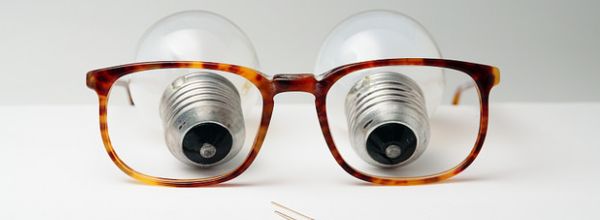While the microscope is synonymous with biology, it is a child of physics and technology. When we learn about the microscope we learn physics—specifically, we learn about optics. Many great resources are available that explain the inner working of microscopy. And, like most things in physics, the inner working of microscopes comes down to a numbers game.
Take the objective, for example. In discussing an objective, we have the following numbers to consider: magnification, resolution, numerical aperture, field of view, working distance, focal distance, tube length, refractive index, coverslip thickness… and there’s probably some more that I’m forgetting. Either way, all these numbers are enough to make your head spin. While all this information is important to the functionality of your objective, I can tell you now that no one ever saved the day by knowing the numerical aperture of a 20x objective.
So from an everyday user point of view, what numbers do you really need to know for optical and digital microscopy?
Magnification Numbers
This is an obvious one, but it’s important to pay attention to what magnification you’re using. Particular work is done at particular magnifications. When you are imaging one slide at a time on an optical system, you will notice quickly when you are at the wrong magnification.
When you graduate to digital systems with autoloaders, or even to High Content Screening systems (where samples can number in the thousands), it is especially important to ensure that you have set up the scans with the correct magnification. Several times I have set up batches of slides to scan, only to find several hours later that they were 20x instead of 40x. If you work in a quiet lab or are scanning small batches, you can write this off easily. However, if you work in a busy lab and have to get through several hundred slides, this can set you back hours—if not days!
Magnification is measured as an x value. For example, a 20x objective magnifies the sample by a factor of 20. Look for the magnification on the objective eyepieces. When using an optical system, the total magnification of your image is the x value of your objective multiplied by the x value of your eyepiece. Therefore, a 20x objective with 10x eyepieces equals a 200x image. In digital microscopy, there is no eyepiece, so you read the x value right from the objective. This means that magnification on a digital system is technically lower. Software corrects for this, though, and digital images are usually better quality.
Scale Bars
After magnification, scale bars are the second most important number in imaging. Incorrect scaling is not as easy to catch. If you are publishing an image, it will need a scale bar. Adding an accurate scale bar after you have completed imaging is a nightmare! Most digital systems (once calibrated) provide accurate scale bars that change in proportion to the magnification that you are using. Some software automatically puts a scale bar on the image. Others will require you to select for the scale bar to be added. As part of your good practices, always add the scale bar to your image. It’s always better to have it and not need it, than to need it and not have it.
How will you know if the scale bar is measuring correctly? Compare what you see to other images—this is where your knowledge of your sample is critical. Check that the scale bar is measuring in units such as mm or nm. If the system is not calibrated, then it will measure in pixels. Pixels are no use to you—unless you really like doing math, in which case you can spend the next several hours converting pixels to mm.
Scaling and calibration differ slightly between machines, so try to do all your imaging on one system—especially if you are doing comparative work. Likewise, if you are using one brand of imaging hardware and a different brand of imaging software, check that the scaling is being correctly converted. Remember, if it looks wrong, it is wrong.
Refractive Index in Immersion Scanning
In short, refractive index (RI) describes how much the light is bent by the medium when it passes through (the sample, the oil/water, and the lens of the objective in this case). RI is important when using an immersion objective, because you need the RI of the objective to match the RI of the immersion liquid to get a clear image. The glass in objectives varies between brands and each will have a slightly different RI. The oil you use for oil imaging will also vary between brands, so make sure the RI of the oil and the RI of the objective match (they don’t have to be the same brand). If they are different, you will not get a clear image.
The RI of the objective is written on the body. For oil objectives, the RI will be labelled as ‘1.45 oil’ for example. On a water immersion objectives, the RI is listed as ‘0.8 water’ (sometimes labelled ‘WI’ or just ‘W’). The RI value for an oil objective is higher than for a water objective as oil bends light at a stronger angle than water does. You can easily source tables of RI values online.
Monitor Settings
Whether you are using a digital system or have an optical microscope with a mounted camera, you need a good quality, high-resolution screen for microscopy imaging. You also need to make sure that the monitor has been correctly configured to show your images at their best. Each system is slightly different, so consult the technical specifications document for your individual system. Are you using the correct resolution, aspect ratio, and color depth? All of these values will make a big difference to how your images look. (Note that these are things you need to adjust on the computer itself—not in your imaging software).
The settings that you use to capture your images should match the settings on the computer you’re going to do your analysis on. Check the monitor’s brightness, contrast, and gamma. You need consistency when working with images. The monitor values are particularly important if you are using a number of different computers or are imaging samples for comparison over time.
If you are having trouble finding this information there are many tutorials online that show you how to find and optimize the graphics settings for your specific monitor.
Memory
Images tend to be quite large files, especially if you are using a high-resolution format such as TIFF. Before you sit down to do an imaging session, make sure you have enough available memory in the location where your images are going to be stored.
Take a few sample images—what size are they? Multiply the average size of these images by the total number of images you plan to capture (add an extra bit for luck). So, for example, if one of my images is 2MB and I have ten slides to image, I need at least 20MB available on the computer or on my USB/external hard drive, with a bit extra for metadata. If there is not enough space, the system will stop running because the images have nowhere to go.
Remember, if you are doing z-stacking, you will need even more space. A five layer z-stack counts as five images. So if I am z-stacking my ten slides that we mentioned previously, I need to have at least 100MB of available space for images and extra for my metadata, which will now also contain z-axis information Fortunately, external hard drives are not expensive to buy. I recently bought a 1TB external hard drive for less than €50 or ~$55 USD (1TB = 1000000MB).
Imaging can be overwhelming, especially when you have a lot of samples to get through and maybe not a lot of time. Make it part of your good practice routine to start every imaging session by running these few numbers and noting them down. You will find your sessions running more smoothly and your images will be more consistent (and trust me on checking the monitor settings, people fiddle with them more than you know!).






